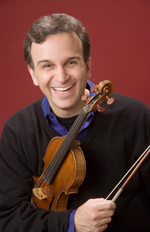by Timothy Robson

Mr. Karabits opened the concert with an energetic reading of Glinka’s Overture to Ruslan and Ludmila. The momentum never lagged, even in the more lyrical moments of the five-minute curtain raiser, whose eponymous opera is almost never performed in the West. Mr. Karabits was a model of efficiency in his conducting, with minimalist baton movements, nods and flicks of his fingers to communicate his directions.
In an interview last week with ClevelandClassical’s Mike Telin, Gil Shaham expressed his enthusiasm for performing the Tchaikovsky concerto, one of the enduring favorites of the romantic violin repertoire. His enthusiasm was apparent in his performance at Blossom. His playing and stage presence showed his total involvement with the music. He sometimes grinned at the conductor or concertmaster; he turned to face the conductor for important cues. He moved around when he was not performing, taking in the orchestral sound.
This was not a “blast through it” performance; rather, the orchestra and soloist were integrated with great restraint, and the performance at times took on the delicacy and precision of chamber music. As is often the case at the brilliant end of the first movement of this concerto, the audience was carried away with enthusiasm, and there was hearty applause, which Mr. Shaham graciously acknowledged with a brief bow of his head.
The Canzonetta second movement’s folk-like melody was played with ravishing beauty, and the entire movement rarely rose above a very quiet dynamic level. The end of the movement was so quiet as to be almost inaudible in the pavilion, but made the sudden jolting fortissimo into the third movement all the more striking. Mr. Karabits did not spare Mr. Shaham with the brutally fast tempo of the movement. In the hands of a lesser violinist or orchestra, there would have been enormous potential for disaster, but this was again performed with utmost virtuosity combined with sensitive musicianship. There was a thunderous ovation at the end, prompting Mr. Shaham to return for an encore, the Gavotte en Rondeau from Johann Sebastian Bach’s Partita No. 3 in E Major, BWV 1006, for solo violin. It was played with sharp rhythms and sense of forward movement.
The second half of the program was devoted to Sergei Prokofiev’s Symphony No. 5 in B-flat Major, Op. 100. Prokofiev himself considered the fifth symphony his finest work. It was also his last great success; a few weeks after the 1945 premiere of the symphony, which he conducted, Prokofiev suffered a heart attack from which he never fully recovered. It was received at the time by the public and Soviet authorities as a great patriotic work celebrating Red Army’s World War II battle victories.
Kirill Karabits abandoned all the restraint he had shone in the Tchaikovsky concerto, adopting a highly dramatic style, with a riot of orchestral color and gleaming climaxes, interspersed with introspective passages that showcased the Cleveland Orchestra soloists. The third movement adagio develops an expressive melody first appearing in the clarinet, eventually building to a grotesque climax, but eventually resolving to an unlikely major final chord. The last movement begins as a march, again with a clarinet tune, later becoming a “perpetual motion,” and ending with frantically, almost comically, but with the “free and happy” spirit that Prokofiev desired.
Published on ClevelandClassical.com August 6, 2013
Click here for a printable version of this article.



